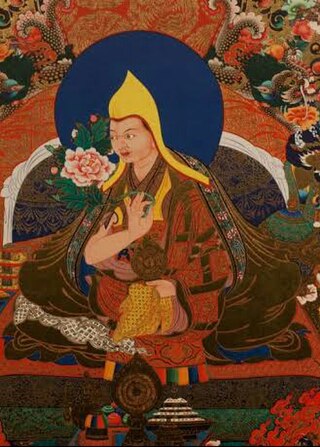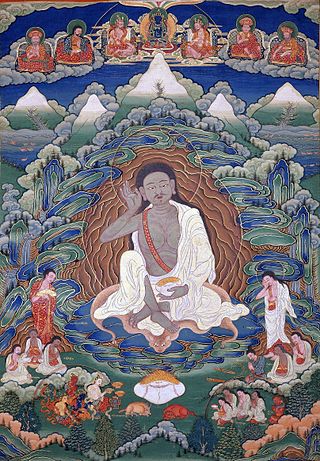
Gedun Drupa was considered posthumously to have been the 1st Dalai Lama.
A tulku is a distinctive and significant aspect of Tibetan Buddhism, embodying the concept of enlightened beings taking corporeal forms to continue the lineage of specific teachings. The term "tulku" has its origins in the Tibetan word "sprul sku", which originally referred to an emperor or ruler taking human form on Earth, signifying a divine incarnation. Over time, this term evolved within Tibetan Buddhism to denote the corporeal existence of highly accomplished Buddhist masters whose purpose is to ensure the preservation and transmission of a particular lineage.

Ngawang Lobsang Gyatso was the 5th Dalai Lama and the first Dalai Lama to wield effective temporal and spiritual power over all Tibet. He is often referred to simply as the Great Fifth, being a key religious and temporal leader of Tibetan Buddhism and Tibet. Gyatso is credited with unifying all Tibet under the Ganden Phodrang after a Mongol military intervention which ended a protracted era of civil wars. As an independent head of state, he established relations with the Qing empire and other regional countries and also met early European explorers. Gyatso also wrote 24 volumes' worth of scholarly and religious works on a wide range of subjects.

Tashi Lhunpo Monastery is an historically and culturally important monastery in Shigatse, the second-largest city in Tibet. Founded in 1447 by the 1st Dalai Lama, it is the traditional monastic seat of the Panchen Lama.
Yamdrok Lake is a freshwater lake in Tibet. It is one of the three largest lakes in Tibet. It is over 72 km (45 mi) long. The lake is surrounded by many snow-capped mountains and is fed by numerous small streams. The lake has an outlet stream, a tributary of Yarlung Tsangpo, at its far western end and means turquoise in English due to its color.

Sera Monastery is one of the "great three" Gelug university monasteries of Tibet, located 1.25 miles (2.01 km) north of Lhasa and about 5 km (3.1 mi) north of the Jokhang.

Ganden Monastery or Ganden Namgyeling or Monastery of Gahlden is one of the "great three" Gelug university monasteries of Tibet. It is in Dagzê County, Lhasa. The other two are Sera Monastery and Drepung Monastery. Ganden Monastery was founded in 1409 by Je Tsongkhapa Lozang-dragpa, founder of the Gelug order. The monastery was destroyed after 1959, but has since been partially rebuilt. Another monastery with the same name and tradition was established in Southern India in 1966 by Tibetan exiles.

Drepung Monastery, located at the foot of Mount Gephel, is one of the "great three" Gelug university gompas (monasteries) of Tibet. The other two are Ganden Monastery and Sera Monastery.

Tsurphu Monastery (Tibetan: མཚུར་ཕུ་དགོན་པ or Tölung Tsurphu is a gompa which serves as the traditional seat of the Karmapa, the head of the Karma Kagyu lineage of Tibetan Buddhism. It is located in Gurum in Doilungdêqên District, Tibet Autonomous Region, China, 70 kilometres from Lhasa.

Muru Ningba or Meru Nyingba is a small Buddhist monastery located between the larger monasteries of Jokhang and Barkhor in the city of Lhasa, Tibet, China. It was the Lhasa seat of the former State Oracle who had his main residence at Nechung Monastery.

Monlam, also known as The Great Prayer Festival, falls on the 4th to 11th day of the 1st Tibetan month in Tibetan Buddhism.

In Tibetan Buddhism and Bon, a ngakpa (male), or a ngakma (female) is any practitioner of Vajrayana who is not a monk or a nun. The terms translates to "man or woman of mantra" or "man or woman of secret mantra". They are often referred to as "householder yogis" or "yoginis" because they maintain a householder lifestyle while engaging in advanced tantric practices.

Nechung Monastery, Nechung Gompa or Nechung Chok, is the seat of the State Oracle of Tibet. It is also referred to as Sungi Gyelpoi Tsenkar, the "Demon Fortress of the Oracle King."
Chokorgyel Monastery is a Buddhist monastery in Gyatsa County in Tibet, China.
Lhamo Latso or Lha-mo La-tso is a small oval oracle lake where senior Tibetan monks of the Gelug sect go for visions to assist in the discovery of reincarnations of the Dalai Lamas. Other pilgrims also come to seek visions. It is considered to be the most sacred lake in Tibet.

In Tibetan Buddhism, Vajravārāhī is considered a female buddha and "the root of all emanations of dakinis". As such, Vajravarahi manifests in the colors of white, yellow, red, green, blue, and black. She is a popular deity in Tibetan Buddhism and in the Nyingma school she is the consort of Hayagriva, the wrathful form of Avalokiteshvara. She is also associated with the Cakrasaṃvara Tantra, where she is paired in yab-yum with the Heruka Cakrasaṃvara.

Drongtse Monastery is a Tibetan Buddhist monastery was formerly one of the most important Gelug monasteries in Tsang, Tibet. There was also a chorten there.

The Samding Dorje Phagmo is the highest female incarnation in Tibet and the third highest-ranking person in the hierarchy after the Dalai Lama and the Panchen Lama. She was listed among the highest-ranking reincarnations at the time of the 5th Dalai Lama, recognized by the Tibetan government and acknowledged by the emperors of Qing China. In her first incarnation, as Chökyi Drönma, she was the student and consort of the famous polymath Thang Tong Gyalpo, who first identified her as an emanation of Vajravārāhī, and the consort of Bodong Panchen. The seat of the Samding Dorje Phagmo is at Samding Monastery, in Tibet.

The Yarlung Valley is formed by Yarlung Chu, a tributary of the Tsangpo River in the Shannan Prefecture in the Tibet region of China. It refers especially to the district where Yarlung Chu joins with the Chongye River, and broadens out into a large plain about 2 km wide, before it flows into the Tsangpo River. It is situated in Nedong District of the Shannan Prefecture and includes the capital of the prefecture, Tsetang, one of Tibet's largest cities, 183 km southeast of Lhasa.

Lhasa is noted for its historic buildings and structures related to Tibetan Buddhism. Several major architectural works have been included as UNESCO's World Heritage Sites.
















